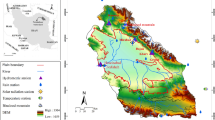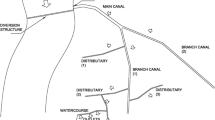Abstract
Changes in the hydrologic balance in many irrigation areas, including those in the Murray Basin, Australia, have resulted in high watertables and salinity problems. However, where suitable aquifers exist, groundwater pumping and subsequent irrigation application after mixing with surface waters (referred to as conjunctive water use) can control salinity and watertable depth and improve productivity of degraded land. In order to assess where conjunctive water use will successfully control salinity, it is necessary to estimate the effects of pumped groundwater salinity on rootzone salinity. A simple steady rate model is derived for this purpose from mass conservation of salt and water. The model enables an estimate to be made of rootzone salinity for any particular salinity level of the groundwater being used in conjunction with surface water; this enables calculation of the required crop salt tolerance to prevent yield reductions. The most important input parameters for the model are groundwater salinity, the annual depth of class ‘A’ pan evaporation, the annual depth of rainfall, the salinity of irrigation water, and a leaching parameter. For model parameters nominated in this paper, where groundwater salinity reaches 5 dS/m a crop threshold salt tolerance greater than 1.6 dS/m is required to avoid yield reductions. Where groundwater salinity approaches 10 dS/m, a crop threshold tolerance of 3 dS/m is required. Whilst the model derived indicates that rootzone salinity is sensitive to groundwater salinity, rootzone salinity is insensitive to leaching for leaching fractions commonly encountered (0.1 to 0.4). The insensitivity to leaching means that it could be expected that similar yields could be attained on heavy or light textured soils. This insensitivity also implies that there is no yield penalty from increasing the mass of pumped salt by pumping to achieve maximum watertable control in addition to leaching. The model developed is also used to estimate yield reductions expected under conjunctive use, for any particular levels of groundwater salinity and crop salt tolerance.
Similar content being viewed by others
References
Ayers RS, Westcot DW (1985) Water quality for agriculture. FAO Irrig Drain Paper 29, Rome 1985
Bernstein L (1975) Effect of salinity and sodicity on plant growth. An Rev Phytopathol 13:295–312
Bernstein L, Francois LE (1973) Leaching requirement studies: sensitivity of alfalfa to salinity of irrigation and drainage waters. Soil Sci Soc Am Proc 37:931–943
Bingham FT, Garber MJ (1970) Zonal salinisation of the root system with NaCl and boron in relation to growth and water uptake of corn plants. Soil Sci Soc Am Proc 34:122
Bower CA, Ogata G, Tucker JM (1969) Rootzone salt profiles and alfalfa growth as influenced by irrigation water salinity and leaching fraction. Agron J 61:783–785
Bower CA, Ogata G, Tucker JM (1970) Growth of Sudan and tall fescue grasses as influenced by irrigation water salinity and leaching fraction. Agron J 61:783–785
Bresler E, McNeal BL, Carter DL (1982) Saline and sodic soils: principles — dynamics — modelling. Springer, Heidelberg
de Wit CT (1958) Transpiration and crop yields. Versl Landbouwk Onderz 64.6 Inst Biol Chem Res Field Crops and Herbage, Wageningen, The Netherlands
Dirksen C (1985) Relationship between root uptake-weighted mean soil water salinity and total leaf water potentials of alfalfa. Irrig Sci 6:39–50
Doorenbos J, Pruit WO (1977) Crop water requirements. FAO Irrig Drain Paper 24, FAO Rome 1984
Doorenbos J, Kassam AH (1979) Yield response to water. FAO Irrig Drain Paper 33, FAO Rome 1986
Fetter CW (1988) Applied Hydrogeology. Merrill Publishing Company, Columbus, Ohio
Hanks RJ (1983) Yield and water use relations. In: Taylor HM, Jordan WR, Sinclair TR (eds) Limitations to efficient water use in crop production. ASA/CSSA/SSSA, Madison, Wis
Hoffman GJ, van Genutchen MTh (1983) Soil properties and eficient water use: water management for salinity control. Chap 2c. In: Taylor HM, Jordan WR, Sinclair TR (eds) Limitation of efficient water use in crop production. ASA/CSSA/SSSA, Madison, Wis
Hoffman GJ, Rawlins SL, Oster JD, Jobes JA, Merrill SD (1979) Leaching requirement for salinity control 1. Wheat, sorghum and lettuce. Agric Water Manag 2:177–192
Ingvalson RD, Rhoades JD, Page AL (1976) Correlation of alfalfa-yield with various index of salinity. Soil Sci 122:145–153
Letey J, Dinar A, Knapp KC (1985) Crop-water production function for saline irrigation waters. Soil Sci Soc Am J 49:1005–1009
Lunin J, Gallatin MH (1965) Zonal salinisation of the root system in relation to plant growth. Soil Sci Soc Am Proc 69:608
Maas EV, Hoffman GJ (1977) Crop salt tolerance — current assessment. J Irrig Drain Div ASCE 103 No IR2:115–134
Mehanni AH, Repsys AP (1986) Perennial pasture production after irrigation with saline groundwater in the Goulburn Valley, Victoria. Aust J Exp Agric 26:319–324
Prendergast JB (1993) A model of crop yield response to irrigation water salinity: theory, testing and application. Irrig Sci 13:157–164
Prendergast JB, Heuperman AF (1988) Groundwater pumping/reuse in N. Victoria: recharge processes, aquifer salinisation and farm productivity. BMR J Aust Geol and Geophys, Groundwater 12:149–154
Prendergast JB, Rose CW, Hogarth WL (1994) Sustainability of conjunctive water use for salinity control in irrigation areas: theory and application to the Shepparton region, Australia. Irrig Sci 14:177–187
Rasmussen VP, Hanks RJ (1978) Model for predicting spring wheat yields with limited climatological and soil data. Argon J 70: 940–944
Rhoades JD (1974) Drainage for salinity control. In: van Schilfgaarde J (ed) Drainage for agriculture. Agronomy Madison, Wis., USA
Shalhevet J, Bernstein L (1968) Effects of vertically heterogeneous soil salinity on plant growth and water uptake. Soil Sci 106:85–93
Shalhevet J, Mantell A, Bielorai A, Shimsi D (1976) Irrigation of field and orchard crops under semi-arid conditions. Int Irrig Info Ctr Pub No 1 Bet Dagan, Israel
Slavich PG (1992) Irrigation using groundwater for watertable control: a model of salt and water balance limitations. Aust J Agr Res 43:225–239
Smith RJ, Hancock NH (1986) Leaching requirement of irrigated soils. Agric Water Manag 11:13–22
Stewart LI, Danielson RE, Hanks RJ, Jackson RM, Hagan WO, Pruit WO, Franklin WT, Riley JP (1977) Optimising crop production through control of water and salinity levels in the soil. Utah Water Lab Pub No PRWG 151-1, USA
van Schilfgaarde JL, Bernstein L, Rhoades JD, Rawlins SL (1974) Irrigation management for salt control. J Irrig Drain Div Am Soc Civil Eng 100:321–328
Author information
Authors and Affiliations
Rights and permissions
About this article
Cite this article
Prendergast, J.B., Rose, C.W. & Hogarth, W.L. A model for conjunctive use of groundwater and surface waters for control of irrigation salinity. Irrig Sci 14, 167–175 (1994). https://doi.org/10.1007/BF00190188
Received:
Issue Date:
DOI: https://doi.org/10.1007/BF00190188




